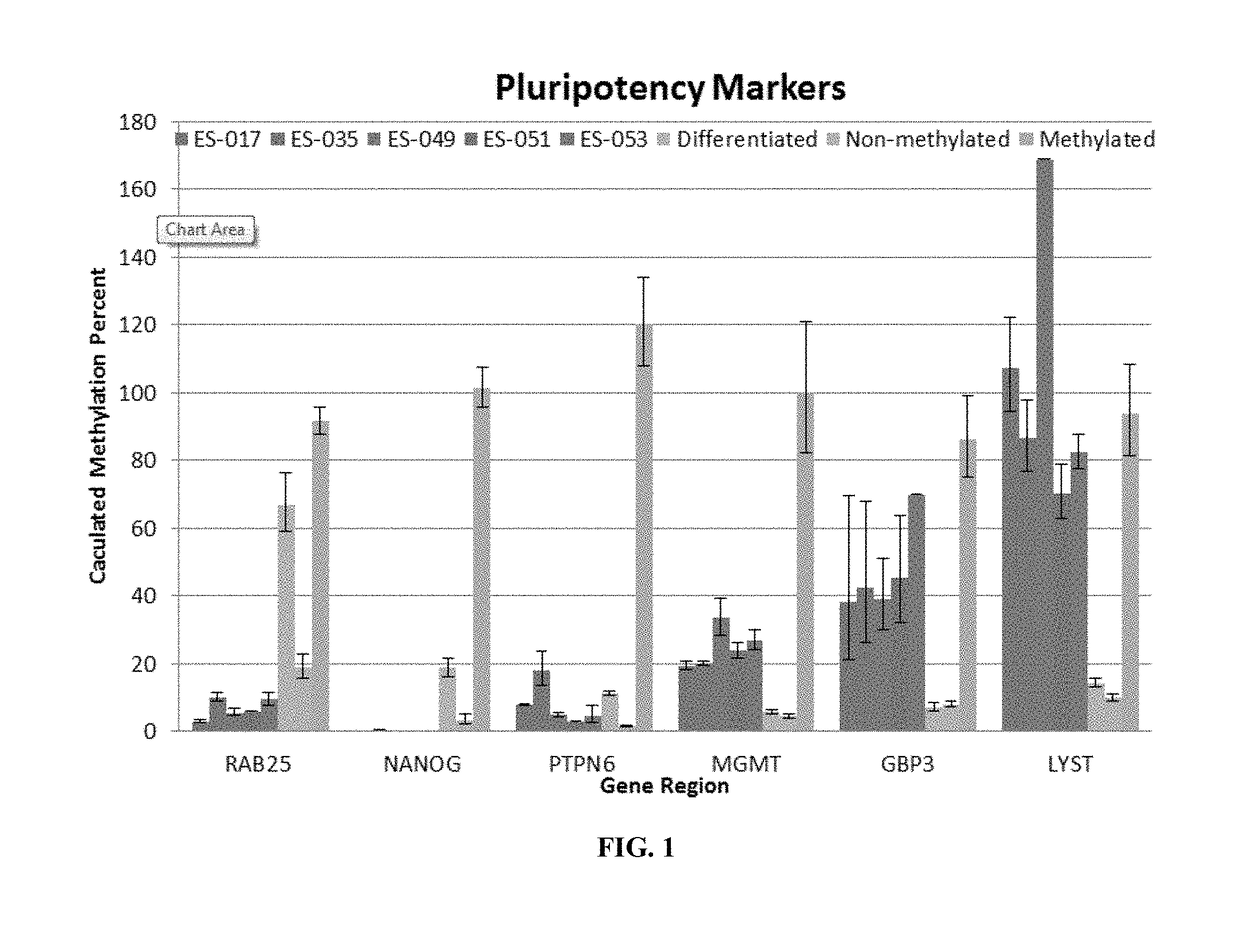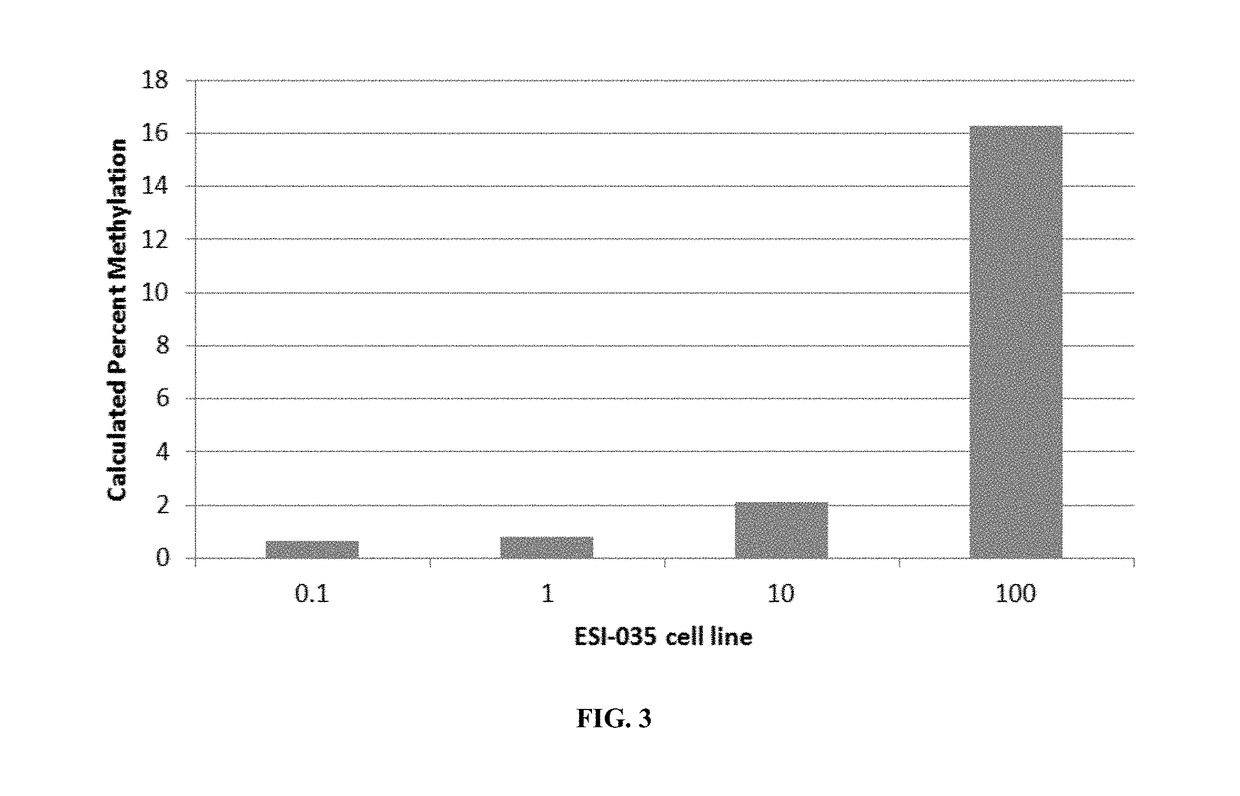Epigenetic markers of pluripotency
a technology of epigenetic markers and pluripotency, applied in the field of molecular biology, medicine and epigenetics, can solve the problems of difficult interpretation of information from such studies, inability to provide a direct and definitive assessment of the differentiation status of cells, and cumbersome methods and other problems, to achieve the effect of assessing the pluripotency of the cell population
- Summary
- Abstract
- Description
- Claims
- Application Information
AI Technical Summary
Benefits of technology
Problems solved by technology
Method used
Image
Examples
example 1
Identification and Validation of Epigenetic Markers of Pluripotency
[0090]A select group of potential epigenetic markers was screened to determine which is any could be used for quantitative assessment of cellular pluripotency. For each candidate marker a four phase study was used to determine the possible value of the marker. Evaluation criterion for each phase is listed below. Results of the evaluations are shown in Table 3 below.
Phase I: Test for Discrimination Between Methylated (M) and Unmethylated (U) DNA
[0091]Studies were undertaken to determine:
[0092](1) Whether a difference between the unmethylated DNA standard and the completely methylated DNA standard was evident. 4 or more CT values between the standards was the cut off used. Theoretically these values should be 0% for the unmethylated and 100% for the methylated standards—however, 10-15% methylation error for both standards was allowed. or
[0093](2) Whether a melt curve showed a single peak.
[0094]If neither (1) not (2) wa...
example 2
Epigenetic Assessment of Pluripotency
[0098]Stem Cell Gene Regions for the OneStep qMethyl™ Analysis
[0099]Markers identified in Example 1 were finalized in to a panel for further testing and assessment. Stem cell gene regions of RAB25, NANOG, PTPN6, MGMT, GBP3, and LYST were converted to their genomic sequence and searched in the University of California Santa Cruz (UCSC) genome data base. The regions were searched for specific methylation sensitive restriction enzymes sites in order to be utilized in the OneStep qMethyl™ system (see, e.g., PCT Publn. WO 2011 / 109529, incorporated herein by reference). Unique primers were designed for real-time PCR using the OneStep qMethyl™ System for each of the six gene regions. Regions contained anywhere from 1 to 4 Methylation Sensitive Restriction Enzyme sites per amplicon. The amplicon sizes ranged from 286 bp to 152 bp. Primers were reconstituted according to their nm concentration to a final concentration of 100 μM. Primer and amplicon sequen...
example 3
Example Reaction Set-Up and Analysis A
[0112]A 96-well plate is arranged with reaction components for MSRE digestions (or undigested control) and PCR. An example plate arrangement is shown in FIG. 5. After initial set-up of the plate with reaction components 5 μl (4 ng / μl) of each DNA sample to be tested is added into the appropriate well. In this example, wells G1-G12 or H1-H12 comprise non-methylated DNAs as a control. The reactions detailed here are compatible with ROX™2 passive reference dye for instruments requiring its usage. Thus, optionally, 1 μl ROX™ dye (50×) is added to a DNA sample prior to adding into the wells (i.e., 4 μl of DNA at 5 ng / μl+1 μl of ROX™ dye).
[0113]After formulating the reactions the plate is sealed and any bubbles removed (e.g., by centrifugation). Reaction conditions are then employed for combined digestion, and real-time amplification of DNA samples. Typically, between 40-45 cycles are used for the amplification of most DNA templates. For real-time PCR...
PUM
| Property | Measurement | Unit |
|---|---|---|
| Mass | aaaaa | aaaaa |
| Mass | aaaaa | aaaaa |
| Fraction | aaaaa | aaaaa |
Abstract
Description
Claims
Application Information
 Login to View More
Login to View More - R&D
- Intellectual Property
- Life Sciences
- Materials
- Tech Scout
- Unparalleled Data Quality
- Higher Quality Content
- 60% Fewer Hallucinations
Browse by: Latest US Patents, China's latest patents, Technical Efficacy Thesaurus, Application Domain, Technology Topic, Popular Technical Reports.
© 2025 PatSnap. All rights reserved.Legal|Privacy policy|Modern Slavery Act Transparency Statement|Sitemap|About US| Contact US: help@patsnap.com



